The relationship between Cascades™ and Qt: Stakes and Opportunities for Blackberry Developers
The respond to this question come from Eun-Kyung and Kizito of Blackberry
Here is what they tell us :
Cascades
and Qt frameworks are two major frameworks available in BlackBerry 10
application development. From a high-level architectural point of view, you can
say that Cascades sits on top of Qt modules as it is built, using the Qt
application framework leveraging Qt object model, event model and threading
model. This also uses QtCore, QtXML, QtSql, QtNetwork and QDeclarativeEngine
for QML components. Both frameworks use standard C++, signals and slots in Qt
for inter-object communication. However, Cascades uses own UI rendering engine
and does NOT use any QtGui functionality, while Qt uses raster and the OpenGL
graphics engine.
The key
point here is that BlackBerry 10 supports BOTH Cascades and Qt frameworks. If you
have developed an application using Qt framework for other platforms, you can
deploy and run the application on BlackBerry 10 with the minimum effort of
fixing a few compile and runtime issues. The downside of this approach is that
your application may not have consistent look and feel with the BlackBerry 10
platform, nor have the best integration with the platform itself.
Cascades
includes a set of core UI components and platform APIs to create interactive
applications accessing the underlying features of the BlackBerry 10 platform.
Cascades UI components are designed to have a consistent look and feel, and are
optimized for BlackBerry 10 integration such as touch screen interactions. You
can use Cascades
Builder, the main
development tool, for creating BlackBerry Native applications, which is built
into the QNX Momentics IDE. The UI preview and the components view are specific
features of Cascades Builder when editing QML. Cascades Builder is also
integrated to access the BlackBerry platform features and services like
audio/video, camera, Ad Service, app integration, BBM™ Social Platform,
external data storage access, file system access, internationalization,
location, payment service, PIM (Personal Information Management), push
services, networking, notifications and sensors. To learn more about the
Cascades framework, see Introduction
to Cascades.



Comments